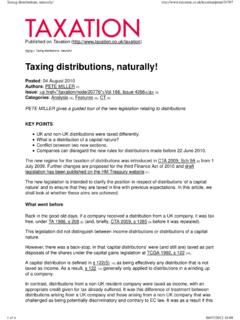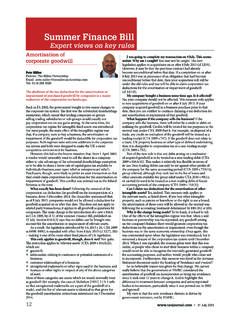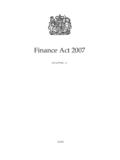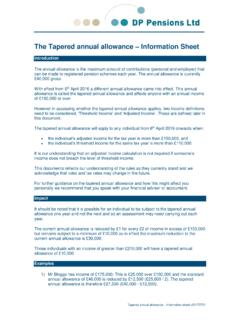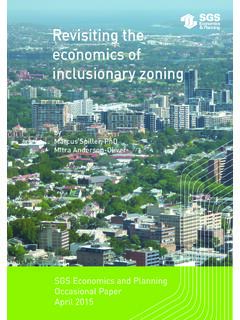Transcription of Statutory Clearances om Fr HMRC - …
1 ISSUE 87 | JULY 10, 2014 FEATURED ARTICLES Statutory Clearances From HMRC by Pete Miller CTA (Fellow), Partner, Th e Miller Partnership Contact: and +44 116 208 1020; website: Th e UK's tax legislation provides for formal clear-ances from HM Revenue & Customs (HMRC) in a number of situations. HMRC also operates an infor-mal system of non- Statutory Clearances , available to all "business customers." Th is article is about statu-tory Clearances , but much of it would apply to non- Statutory Clearances , too. Th ere is useful advice on HMRC's website at Th e most common Statutory Clearances are those for share exchanges (s138, Taxation of Chargeable Gains Act 1992 (TCGA 1992)), schemes of recon-struction (ss138, 139(5), TCGA 1992), share buy-backs (s1045, Corporation Tax Act 2010 (CTA 2010)), demergers (s1091, CTA 2010, which I once worked on while at the Inland Revenue, one of the predecessor bodies to HMRC), and transac-tions in securities (s701, Income Tax Act 2007).
2 Timing HMRC must give a substantive response to clear-ance applications within 30 days of receipt. Th is deadline is taken extremely seriously, and I have never known it not to be adhered to. In practical terms, this means that once you have sent a clearance application, it may take a month before HMRC replies. And if HMRC has material questions, the 30-day clock restarts once you have answered those questions. In extreme cases it may take two or three months to get a clearance. In practice, the turnaround time depends on how busy the clearance offi ce is and on the complexity of the ap-plication. Recently, I have been getting Clearances in less than a week, but this cannot be relied upon. In practical terms, it is important to build the tim-ing into the transaction timetable and to manage clients' expectations.
3 In large corporate fi nance transactions there will often be a formal timetable for the various work streams, so that the process can be controlled. Th at timetable should include the timing for tax Clearances . If, as advisers, we are asked about tax at the last minute, which happens all too often, it may be impossible to get a clearance in time for the preferred completion date. In smaller cases, there may not be a formal timetable, but the client often has a timescale in mind, such as 27the end of the accounting period or before they go on holiday. So it is crucial to manage those expectations. Th ere is an interaction between timing and the lev-el of detail required in the clearance application. Often the exact details of the transaction elements are not important in the context of the clearance sought.
4 For example, share exchange Clearances ask if HMRC is satisfi ed that the transactions are being carried out for commercial reasons and not to avoid tax. In most cases, details such as the exact terms of the shares or debentures issued in the exchange are not important in this context. So a clearance ap-plication can be made at an early stage, even if the exact terms have not been completely determined. Sometimes you might need to update HMRC with the fi nal terms, but this is unusual. Urgent Applications Sometimes, it is unavoidable that a clearance is sought on short notice. In these cases, HMRC will do its best to help, but you need to make clear the letter is urgent. I recommend that the top of the fi rst page of the letter be marked in large bold let-ters with "urgent, please" and the date by which you need your clearance.
5 Th e urgency should then be explained early in the letter. Contents Th e letter has to tell a story: What is this company? What does it do? How has it reached the current position? What needs to change? And why? You want the HMRC offi cer to be able to read the let-ter, understand what needs doing and confi rm that the clearance should be given. Speaking from ex-perience as an inspector, a confused or badly writ-ten letter is most likely to generate a request for clarifi cation. Worse still, a badly written letter may suggest that clearance should be refused, perhaps through lack of a commercial reason. So clarity of story telling is essential. Material Information Equally important is to provide all the material information.
6 A clearance based on an application without all the material facts is not a valid clear-ance. If this comes to light, it usually happens after the transaction has been carried out, so that the tax consequences we have been trying to prevent will, instead, come home to roost. My rule of thumb is that, if you are not sure wheth-er a fact is material in a particular case, put it into the clearance application. Th at way, if it is material we fi nd out before it is too late, and if it is not ma-terial, it does not matter. What Happens At HMRC? Th e Clearances for capital gains, demergers, transac-tions in securities, and purchases of own shares are dealt with in a single offi ce, the "one-stop shop." Th e letters are logged in order of receipt and immediate-ly given to an offi cer for an initial sift.
7 Many appli-cations, probably the majority, are straightforward, so the offi cer can grant the clearance immediately. Some cases need more consideration, so you will re-ceive an acknowledgement of the application, with 28a reference and a date by when you should have a substantive answer. If you receive one of these, it does not mean that HMRC wants to refuse your application, merely that your case needs the extra thinking time. In the vast majority of cases, clear-ance is eventually granted. Refusals What do you do with a refusal? Some of the clear-ance facilities, such as those for reorganizations and reconstructions and demergers (but not the trans-actions in securities rules), contain a right to re-quest a review of the correspondence by the First-tier Tribunal (which should be done within 30 days of HMRC's decision).
8 Th ere is no hearing to at-tend, but make sure you set out your arguments clearly and logically in a letter, so the Tribunal can consider your case more effi ciently. If the Tribunal grants clearance, this is binding on HMRC. If you have a refusal, from HMRC or the Tribunal, you are still entitled to carry out the transactions. Obviously, this is a high-risk strategy, as HMRC is likely to challenge it and you will have to fi ght your case through the normal appeals process. So I would not normally recommend this route. Before any of this, though, consider speaking to the clearance offi cer. HMRC must explain why it has refused clearance. Sometimes, this is a misunder-standing, and a telephone conversation might clear things up.
9 Or the elements that concern HMRC may not be of commercial importance to your clients, so you can tweak the transactions so that HMRC can grant clearance. Th is more personal approach is also likely to be faster than asking the Tribunal for a decision. Meaning Of Clearances It is important to understand what a clearance actu-ally means, and its limitations. With demergers, for example, the transactions must satisfy the detailed conditions of ss1081 1085, CTA 2010, and clear-ance implies that HMRC accepts, on the informa-tion supplied, that those conditions are all satisfi ed. In contrast, Clearances for reconstructions only state that HMRC is satisfi ed, from the information supplied, that the transactions are for genuine com-mercial reasons and not to avoid corporation tax, capital gains tax or income tax.
10 HMRC is not able to confi rm that the transactions will amount to a scheme of reconstruction, so it is up to us, as advis-ers, to be satisfi ed that they do. Or Not Bother! Finally, remember that you do not have to seek a pre-transaction clearance. Th e reliefs are generally man-datory, so long as the conditions are satisfi ed, and the facilities for a pre-transaction clearance are there to give taxpayers certainty. HMRC cannot demand that you apply for a clearance nor express suspicion when you have not. Indeed, there may be occasions when you choose not to apply for a clearance, due to time pressures or because you do not wish to disclose to HMRC any more detail than you have to by law. You are perfectly entitled to exercise your rights not to make an application in those cases.
